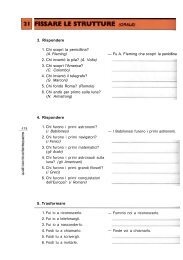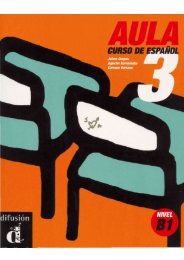III. The Beginnings of Transformation
III. The Beginnings of Transformation
III. The Beginnings of Transformation
Create successful ePaper yourself
Turn your PDF publications into a flip-book with our unique Google optimized e-Paper software.
BEGINNINGS OF TRANSFORMATION<br />
<strong>The</strong> regions <strong>of</strong> the upper Pyramus, or Gaihan, River likewise suffered.<br />
Al-Harawi, the Arab traveler <strong>of</strong> the late twelfth century, found the town<br />
<strong>of</strong> Arabissus in ruins 110<br />
whereas Albistan and the regions <strong>of</strong> the upper<br />
Pyramus were very seriously depopulated by the expedition <strong>of</strong> Yakub<br />
Arslan in 1155-56. 111<br />
Marash was able to resist the Turks in the early<br />
period but changed hands between Christians 112<br />
1 1 3<br />
severely by an earthquake either in 1114 or 1115.<br />
and was damaged<br />
Muhammad the<br />
Danishmendid burned the environs <strong>of</strong> Marashand its villagesin 1136-37 114<br />
and Kïlïdj Arslan took it in 1148. 115<br />
<strong>The</strong> regions <strong>of</strong> the Euphrates in<br />
southeastern Anatolia were similarly exposed to the vicissitudes entailed<br />
in the competition <strong>of</strong>various Turkish dynasties and in the raid <strong>of</strong>Turkish<br />
tribes, the upheaval extending as far south as Antioch. 116<br />
Here the<br />
situation is somewhat clearer as the texts <strong>of</strong> Matthew <strong>of</strong> Edessa and<br />
Michael the Syrian take as their focal points Edessa and Melitene<br />
respectively. In 1120-21 the Artukid Ilghazi burned the villages, en<br />
slaving and massacring the populations, from Tell Bashir northward to<br />
Kaisum. 117<br />
Shortly after 1134 Afshin pillaged the regions <strong>of</strong> Kaisum only<br />
to be followed by Mas'ud who in his first raid pillaged and took captives<br />
in the neighborhood. He returned a second time and reduced to ashes the<br />
nearby villages. 118<br />
In 1136-37 Muhammad the Danishmendid burned<br />
the villages and monasteries <strong>of</strong> the land about the town, including the<br />
monastery <strong>of</strong> Garmir Vank. 119<br />
In 1140-41 the inhabitants temporarily<br />
abandoned the town and so the Turks sacked and burned it. 120<br />
Finally<br />
in 1179 Kïlïdj Arslan destroyed its walls and carried the inhabitants <strong>of</strong>f<br />
into captivity. 121<br />
Edessa resisted the Turks for a comparatively long time, though it had<br />
been besieged and its environs ravaged on numerous occasions by the<br />
end <strong>of</strong>the eleventh century. 122<br />
But the Turkish pressure on the regions <strong>of</strong><br />
1 1 0<br />
Al-Harawi, trans. J. Sourdel-Thomine, Guide des lieux de pèlerinage (Damascus, 1957),<br />
p.135-<br />
1 1 1<br />
Matthew <strong>of</strong> Edessa, p. 344.<br />
1 1 2<br />
Michael the Syrian, <strong>III</strong>, 173. Anna Comnena, <strong>III</strong>, 40-41.<br />
113 William <strong>of</strong> Tyre, XI, xxiii. Bar Hebraeus, I, 247.<br />
1 1 4<br />
Matthew <strong>of</strong> Edessa, pp. 320-321.<br />
1 1 5<br />
Michael the Syrian, <strong>III</strong>, 290, at which time the church treasures were taken.<br />
1 1 6<br />
Sawirus ibn al-Mukaffa', II, iii, 320, speaks <strong>of</strong>disorders, captivity, and assassinations in<br />
1077 following the occupation <strong>of</strong>the land by the Turks.<br />
1 1 7<br />
Matthew <strong>of</strong> Edessa, p. 302. "From Tell Bashir to Kaisum he enslaved men and<br />
women, massacred without pity, and burned and roasted infants in great number with<br />
unparalleled barbarity. After crossing the Euphrates with considerable forces, he exterminated<br />
the population <strong>of</strong> a great number <strong>of</strong>villages; priests and monks perished by iron<br />
and fire."<br />
1 1 8<br />
Michael the Syrian, <strong>III</strong>, 245-246.<br />
1 1 9<br />
Matthew <strong>of</strong> Edessa, pp. 320-321.<br />
1 2 0<br />
Gregory the Priest, pp. 324-325.<br />
1 2 1<br />
Michael the Syrian, <strong>III</strong>, 388.<br />
1 2 2<br />
It was attacked by Gumushtekin in 1066. Bar Hebraeus, I, 217. <strong>The</strong> emir Khusraw<br />
raided the area between 1081 and 1083, Matthew <strong>of</strong> Edessa, p. 185. Buzan took the city<br />
after a long siege attended by famine in 1087—88. Matthew <strong>of</strong> Edessa, p. 198. Shortly<br />
thereafter it was taken by Tutuch who restored it to Thoros. Matthew <strong>of</strong> Edessa, p. 208.<br />
156






